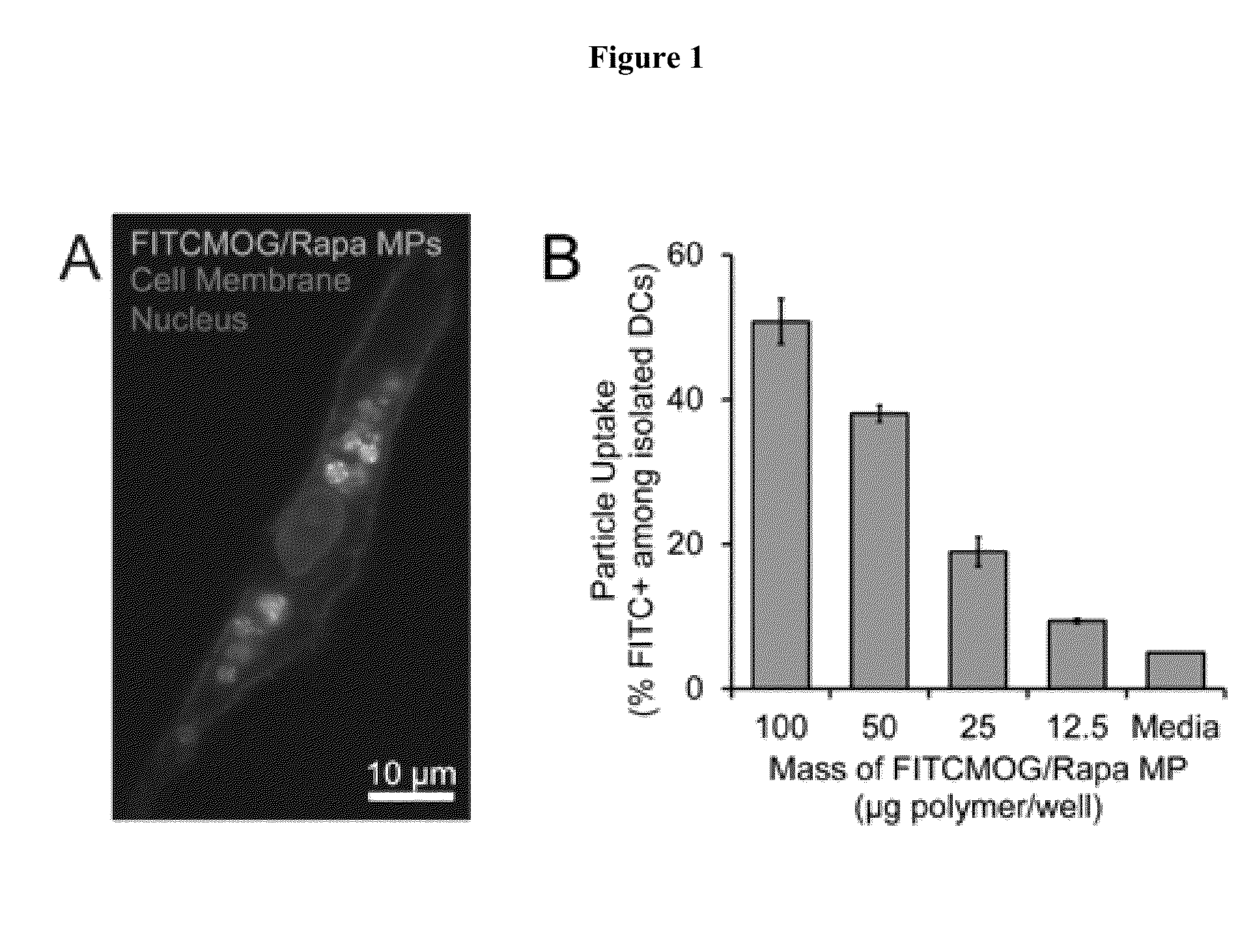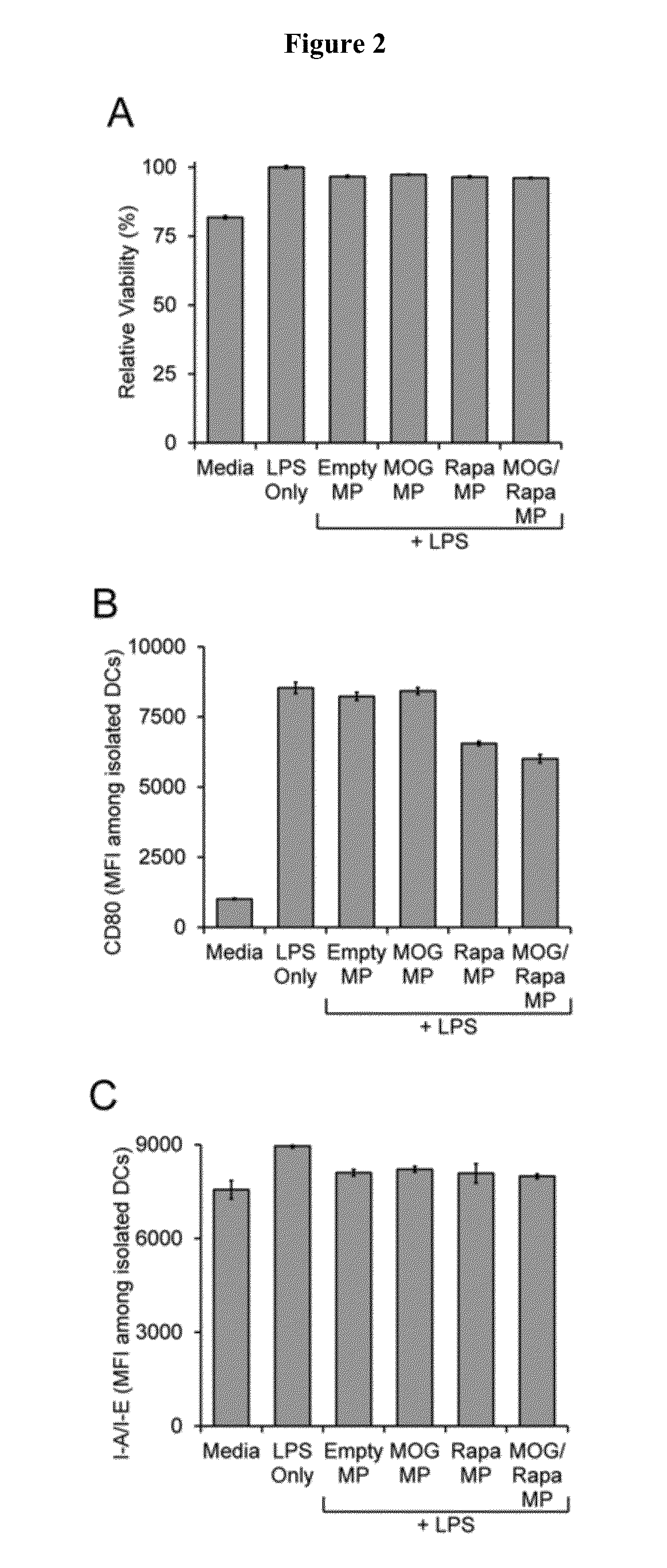Local engineering of the lymph node environment to promote immune tolerance
a technology of lymph node environment and lymph node, applied in the direction of snake antigen ingredients, antibody medical ingredients, pharmaceutical active ingredients, etc., can solve the problems of severe functional limitation, unmet needs for improved approaches, and difficult to direct the immune response in a particular population (e.g., regulatory t cells, tregs), so as to reduce the severity of at least one ms symptom in the individual, and reduce the severity of ms symptoms
- Summary
- Abstract
- Description
- Claims
- Application Information
AI Technical Summary
Benefits of technology
Problems solved by technology
Method used
Image
Examples
example 2
[0031]This Example demonstrates that controlled MP loading modulates primary immune cell activity in vitro. MP formulations were tested in in vitro assays with primary immune cells to screen their tolerogenic potential. To verify that cells could be internalized by antigen presenting cells (e.g., dendritic cells, DCs), CD11c+ DCs were isolated from the spleens of C57BL / 6J mice by magnetic selection. MPs encapsulating fluorescently tagged peptide (FITCMOG) and Rapa were incubated with DCs and were efficiently internalized in a dose-dependent manner (FIG. 1).
[0032]We characterized the effects of our MPs on DCs. First, isolated DCs were treated with soluble lipopolysaccharide (LPS), a strong agonist of innate immunity, to trigger the activation of the cells. To investigate the potential of MPs to attenuate LPS-induced activation, equal masses (100 μg of polymer / well) of MPs were added to wells in the four different formulations: 1) Empty, 2) MOG, 3) Rapa, and 4) MOG / Rapa. After 24 hour...
example 3
[0035]This Example demonstrates that i.LN. delivery of MOG / Rapa MPs prevents or delays autoimmunity in mice.
[0036]We investigated whether the tolerogenic effects observed in vitro would translate to control of autoimmunity in vivo after targeted delivery of particles to the inguinal LNs of mice. A common, well-characterized model of progressive MS, Experimental Autoimmune Encephalomyelitis (EAE) was induced according known approaches and the manufacturer's instructions (Hooke Laboratories). Briefly, naïve C57BL / 6J mice were immunized with an emulsion of MOG peptide and Complete Freund's Adjuvant, a potent immunostimulatory signal. Together, these signals trigger the expansion of myelin-specific CD4+ cells with inflammatory phenotypes (i.e., TH1 and TH17). Two and twenty-four hours later (two total doses), mice were administered pertussis toxin, which compromises the blood brain barrier, allowing myelin-specific CD4+ cells to infiltrate into the central nervous system (CNS) and attac...
example 4
[0038]This Example demonstrates that i.LN. injection confers enhanced therapeutic effect over peripheral route. We conducted experiments to test two potential advantages of i.L.N. administration: 1) enhanced potency and efficacy, and 2) minimized off-target effects due to localization of signals in LNs rather than systemic administration. In particular, an experiment was conducted to benchmark i.LN. delivery against a peripheral route commonly used in vaccination, intra-muscular (i.m.) injection. Mice were induced with EAE and treated either i.LN. or i.m. with Empty or MOG / Rapa MPs ten days post induction. The i.m. injections were administered bilaterally in the hind limbs, and incorporated the same dose of MPs as i.LN. injection regimens.
[0039]No significant differences were observed in clinical score progression of untreated mice and mice administered Empty MPs i.LN. was observed (data not shown). This result confirmed that any tolerogenic effect could be attributed to encapsulate...
PUM
| Property | Measurement | Unit |
|---|---|---|
| diameters | aaaaa | aaaaa |
| hydrophobic | aaaaa | aaaaa |
| composition | aaaaa | aaaaa |
Abstract
Description
Claims
Application Information
 Login to View More
Login to View More - R&D
- Intellectual Property
- Life Sciences
- Materials
- Tech Scout
- Unparalleled Data Quality
- Higher Quality Content
- 60% Fewer Hallucinations
Browse by: Latest US Patents, China's latest patents, Technical Efficacy Thesaurus, Application Domain, Technology Topic, Popular Technical Reports.
© 2025 PatSnap. All rights reserved.Legal|Privacy policy|Modern Slavery Act Transparency Statement|Sitemap|About US| Contact US: help@patsnap.com



